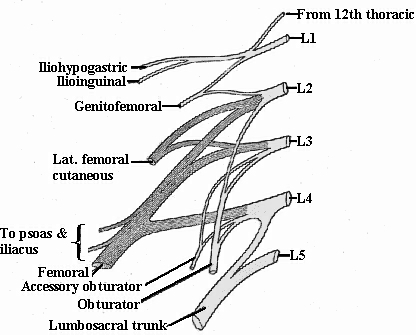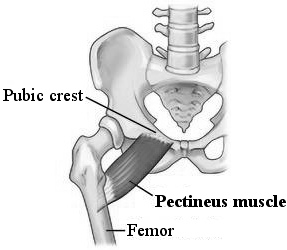A group of nerves formed from vertebral levels L4-S3 of the spinal cord, which are responsible for innervating most of the structures in the lower limb (see figure below).

A group of nerves formed from vertebral levels L4-S3 of the spinal cord, which are responsible for innervating most of the structures in the lower limb (see figure below).

Lumbosacral plexus.
Iliohypogastric nerve: a branch of the first lumbar nerve with branches distributed to the skin of the lateral buttocks and the pubic area, and the muscles of the anterolateral abdominal wall.
Ilioinguinal nerve: another branch of the first lumbar nerve distributed to the muscles of anterolateral abdominal wall, the skin of the proximal and medial parts of the thigh, and the base of the penis and the scrotum and in females the labora majora.
Genitofemoral nerve: arises from the first and second lumbar nerves and distributed via branches to the skin of the scrotum or labora majora as well as of upper anterior part of the thigh.
Lateral femoral cutaneous nerve: arises from the lumbar plexus through connections between branches from the dorsal parts of the ventral divisions of the second and third lumbar nerves, and which also supplies the anterior and lateral parts of the thigh down to the knee.
Iliacus: a flat, triangular muscle lying deep in the pelvis, attaching from the pelvis to femur bone, and which is primarily responsible for flexing and rotating the thigh.
Femoral nerve: the largest and longest of the lumbar nerves, it is one of a pair of nerves that originate from the lumbar nerves and supply the muscles and skin of the anterior part of the thigh.
Accessory obturator nerve: they are L3-4 nerve fibers that are usually convened by the obturator nerve consisting of a separate nerve nerve projecting independently to pectineus muscle and the hip joint. It has been the fourth to be present in only about 30% of cases, but this figure is open to debate.
Pectineus muscle: a flat, quadranguar muscle that lies at the top of the inner thigh and which is mainly responsible for hip flexion as well as adducting and rotating the thigh. See figure below:

Pectineus muscle that is attached like the iliacus muscle from the pelvis to femoral shaft.
Obturator nerve: a branch of the lumbar plexus arising from the second, third and fourth lumbar nerves and which supplies the hip and knee joints, the abductor muscles of the thigh, and the skin of the thigh.
Lumbosacral trunk: sheet of nerve tissue formed by the anterior branch of the fifth lumbar nerve and a smaller anterior branch of the fourth lumbar nerve, and which connects the lumbar plexus to the sacral plexus,
See Brachial plexus, Dorsal, Plexus, Psoas muscle, Spinal cord, Ventral